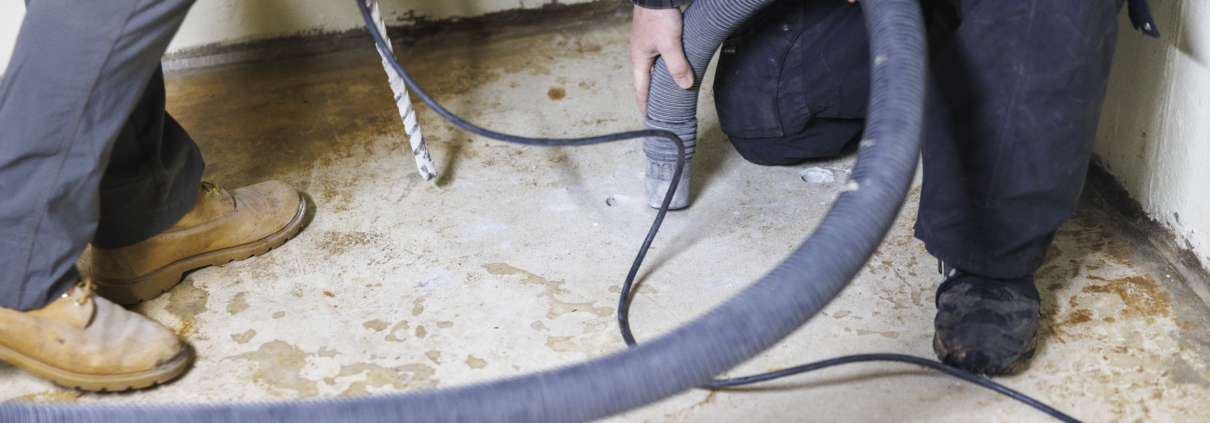What Is A Radon Mitigation System?
Radon, a radioactive gas, is formed from uranium’s breakdown. This colorless gas with no smell or taste is the second largest cause of lung cancer. The EPA, U.S. Environmental Protection Agency, has raised a major concern about the impact of excessive radon in the air, estimating more than 20000 lung cancer deaths facilitated by radon. Further, the American Lung Association’s State of Lung Cancer Report published on 14th January 2022 indicates that Connecticut residents may also find themselves in the presence elevated concentrations of radon in the air. The report says that 25.8% of Connecticut’s radon test results are equal to or more than the Action level of 4 pCi/L as per EPA guidelines. These facts make it necessary to know how to get rid of radon in the air.
The Department of Public Health in Connecticut has responded to this with a Radon Program, recommending that residents get radon testing done at their homes. The testing is usually done with short-term and long-term devices. The Connecticut Department of Health has its list of Nationally Certified (by AARST-NRPP or NRSB) Measurement Professionals who conduct this testing. These professionals are further registered at the Connecticut Department of Consumer Protection. The state also helps find qualified professionals to help mitigate or reduce radon levels in your home.
But as a homeowner, you also need to be aware of radon mitigation and how it is done. So, here we are to discuss radon mitigation and radon mitigation systems.
What is Radon Mitigation?
The process of reducing the levels of radon gas concentration in a home’s or occupied building’s breathing zone is called radon mitigation. Radon mitigation starts if the level of radon in the air is found to be equal to or more than the EPA Action level of 4.0 pCi/L. You need to contact a qualified and certified professional for mitigating radon from air and water.
The contractor will decide the best radon reduction method for your home. Further, s/he will install a system for radon mitigation in your home. S/he will also guide you on the proper maintenance of the system.
RELATED ARTICLE: Radon In Water
What is a Radon Mitigation System?
A radon mitigation system is used to decrease the level of radon in the air. A radon mitigation system is usually constituted of a radon fan, U-tube manometer, radon system tag, active notification monitor, suction pit, and radon pipe.
The radon fan is placed in a garage, attic, unconditioned space, or outside the house to stop radon from leaking back into the home. Further, the fan will never be placed in a livable place or anywhere near the livable space. The fan will be connected to a PVC radon pipe, and the pipe will pull the radon found in the foundation or basement of a house when inserted through a suction pit and expel radon outside into the air.
The U-tube manometer in the mitigating system will help track whether the fan is working properly. The active notification monitor functions as an alarm in case the fan fails to function properly. Finally, the radon system tag has the name, phone number, and license number of the installer, along with the installation date. The professional installer of a system will put the tag on it once the installation work is complete.
What is the Most Common Method of Radon Mitigation?
An Active Subslab Suction, also known as Subslab Depressurization, is the most reliable and common method of radon mitigation. In this method, the professional will insert one or multiple suction pipes through the floor slab (indoor) or a concrete slab (outdoor). The suction pipes will reach the soil or crushed rock under the slab to suck out radon. Further, the suction pipes will be connected to a vent fan that will release the sucked radon gas to the outdoors. The fan will also create a negative pressure or vacuum under the floor or concrete slab for radon mitigation.
Other common methods of radon mitigation are:
- Passive Subslab Suction
- Drain-Tile Suction
- Block-Wall Suction
- Sump-Hole Suction
- Crawlspace Ventilation
- Sealing
- Heat Recovery Ventilation
- Natural Ventilation
- Home or Room Pressurization
How to Install Radon Mitigation System?
The installation procedure of a radon mitigation system is divided into three steps, before mitigation, during mitigation, and after mitigation. Before mitigation, a professional radon test is conducted to know the level of radon in the air. Then, the hired professional contractor assesses your home to understand how the mitigation system can be built.
RELATED ARTICLE: What Is Radon Testing?
During mitigation, the contractor will decide the right fan size for your home and ensure the installation has been done properly. S/he will also get the cracks and openings in the basement sealed so that no radon leakage happens. Finally, s/he installs the mitigating system following a step-by-step process mentioned below.
- Drilling a hole into the basement slab suitable for inserting a 3-inch PVC pipe
- Digging the suction pit from where the pipe will collect radon
- Running a pipe from cellar to the exterior, ensuring the pipe is at least 10 ft above the ground level, placed away from windows, doors, openings of that specific building and adjacent buildings by at least 10 ft if the pipe does not expel the sucked radon gas at least 2ft above these building openings and roof edge
- Placing and sealing the pipe
- Running the pipe to the vent fan
- Manometer installation
- Testing the mitigation system
At the after-mitigation stage, the professional will explain the operations of the mitigation system to the homeowners. S\he will conduct a radon test to ensure the radon level has decreased post the mitigation process.
Does Radon Mitigation Improve Air Quality?
Yes, radon mitigation improves air quality in a space. Especially those mitigation systems with fan vents can ensure powerful moisture suction from the area in the basement or under the foundation slab. Thus, the humidity in your home air will be reduced, and you will enjoy fresher and cleaner air with less chances of musty odors.
Further, an EPA report suggests that mold exposure and excessive dampness are the reason for 21% of asthma cases in the United States. So, by reducing mold growth, a radon mitigation system will also combat the spread of disease in your house.
The reduced humidity in the air prevents the rapid infestations of viruses, bacteria, mold, dust, and other elements that spread asthma, allergy, and many respiratory problems.
What is the Cost of a Radon Mitigation System?
The cost of a radon mitigation system depends on many factors like the type of foundation (basement, crawl space, on-grade slabs) your house has, the design and size of your house, system type used, climate and location, labor and permit charges in your locality, type of equipment used, etc. Further, whether you are using a DIY kit or seeking professional assistance for radon testing will determine the cost of a radon mitigation system. DIY kits are cheaper but do not always produce comprehensive results. You should always seek professional help for radon testing and system installation.
Nevertheless, installing a radon mitigation system in your home will cost between $1500 and $4000. However, the cost can increase if you have a large property with multiple foundations.
Final Words
Hopefully, now you have a clear idea about how radon reduction systems work and why they are essential to eliminate cancer-causing radon in the air of your indoor space. Besides installing a mitigation system, you can also make some changes in the overall ventilation system in your house (along with natural ventilation) so that an increased airflow reduces the radon level in the air.




